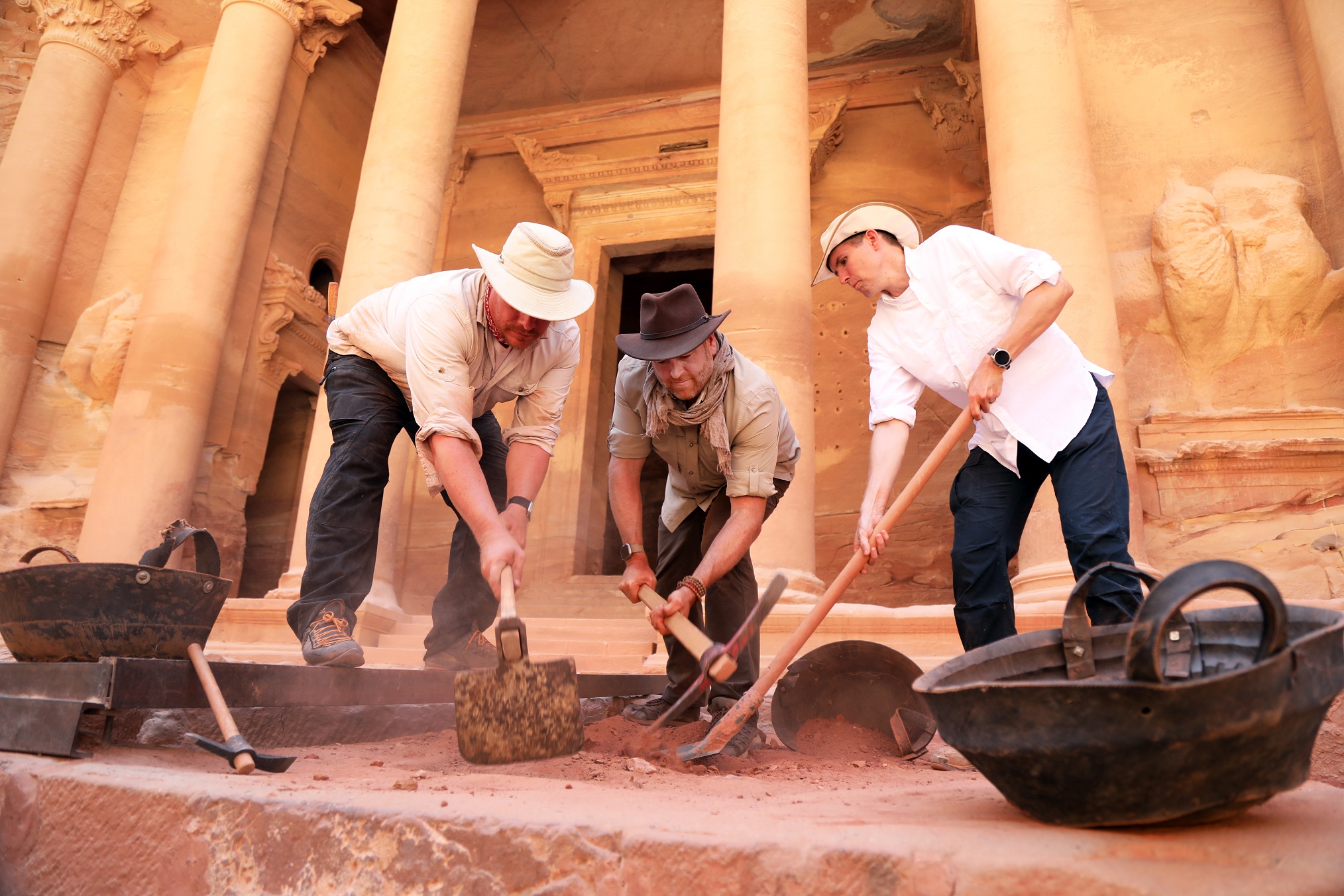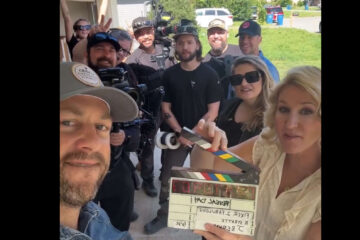Josh Gates has taken viewers on thrilling adventures, from uncovering a lost city in the remote jungles of Cambodia to diving into the Caribbean seas in search of sunken treasure. Now, the explorer embarks on a new mission—unsealing a long-hidden tomb containing ancient skeletons.
This significant archaeological discovery, found beneath the renowned Treasury building in Petra, Jordan, is featured in the latest season of Gates’ *Expedition Unknown*.
Around 2,000 years ago, the Nabataean Kingdom meticulously carved an entire city into the canyon walls of the desert, with the stunning “Treasury” at its heart. Although made famous as the resting place of the Holy Grail in *Indiana Jones and the Last Crusade*, the true purpose of this majestic structure continues to puzzle historians.
This quest for answers was part of a collaborative effort between Jordanian and American researchers, led by Professor Pearce Paul Creasman, Executive Director of the American Center of Research (ACOR).
His team received rare authorization to conduct remote sensing scans and excavations beneath The Treasury. Their work revealed a remarkable find—a tomb containing at least a dozen Nabataean burials directly beneath the iconic structure, which draws over a million visitors each year.
In anticipation of the two-part season premiere, Josh Gates offers a glimpse into this groundbreaking excavation and what viewers can expect from the remarkable discovery.

What factors influence the choice of a destination?
Josh Gates: We always aim to visit places where there’s an active investigation happening. We have a global network of archaeologists and producers who stay informed about ongoing digs. Our goal is not just to explore a mystery or legend, but to actively participate in the investigation and see what we can uncover to advance the story.
With Petra, we had previously worked with lead archaeologist Pearce Paul Creasman in Sudan, where he was excavating a submerged pyramid.
As the Executive Director and Professor at ACOR, he told us, “We’re about to begin an exciting season at Petra, and I think you should join us—it’s going to be something special.” The moment we heard that, we were ready to go.
Talk about some of the physical demands this particular exploration entailed.
As we often say, it’s never easy. Archaeology is tough, and exploration can be extremely challenging. For this project, we used a lot of incredible 21st-century technology.
One key tool was ground-penetrating radar (GPR), which allowed us to scan the area in front of The Treasury—the most iconic structure in Petra, famously associated with the Holy Grail in Indiana Jones and the Last Crusade.
This technology enabled us to conduct noninvasive scans in front of one of the new Seven Wonders of the World. Petra is a World Heritage Site that attracts a million visitors each year, so you have to be extremely careful in a place like that. But once the technology detects something, as it did beneath The Treasury, the real physical work begins.
We had to move tons of earth and sift through it bucket by bucket to look for any valuable material culture. Additionally, exploring the deserts of Jordan to better understand the Nabataeans and their world took us to some very remote places
. One of those places was Sela, a desert fortress where the Nabataeans truly came into their own. This part of the exploration had us hanging off a cliff, attempting to scan an ancient inscription that had been left there thousands of years ago.
Exploration is not easy, and that’s precisely why many of these mysteries have persisted for so long. It requires a tremendous amount of hard work to dig beneath the surface and uncover what’s really happening
It’s fascinating how little is known about the Nabataeans. What are you most excited for viewers to discover about who they were?
The Nabataeans are somewhat the unsung heroes of the ancient world. While most people are familiar with the Romans, Greeks, and Egyptians, the Nabataeans controlled a vast trade empire thousands of years ago.
They were the key connectors of some of the most important trade routes in the world, and because of that, they became incredibly powerful and influential. But beyond their power, they were also highly sophisticated. Petra, their capital city, is a stunning example of their ingenuity, with entire buildings carved directly into solid rock.
These structures aren’t just simple carvings—they’re elaborate facades meticulously etched into the sandstone, showcasing remarkable engineering and artistic skill.
What’s particularly exciting is that the Nabataeans didn’t just create in isolation. They borrowed from the many cultures they encountered through trade. You can see Greek and Roman influences in their architecture, such as the design of their temples and columns. There’s even a Roman-style amphitheater at the heart of Petra, which reflects their cultural fusion.
This was a remarkably advanced society, yet we know so little about them. Much of their history has faded over time, leaving behind only these incredible remnants. I’m most excited for viewers to learn about the sophistication and influence of the Nabataeans—a culture that played a crucial role in the ancient world but has largely vanished into the shadows of history.
The tombs above you are empty, but as you go down, you find remains and 12 ancient skeletons. How surprised were you by those findings?
The discovery we made in this episode far exceeded anything I could have ever anticipated. When you visit a world wonder like Petra, you don’t expect to conduct such a significant excavation at such an iconic site, let alone make a discovery of this magnitude.
Finding something this extraordinary is incredibly rare. Most of the tombs in Petra have been found empty. Petra was never fully abandoned by the local people, and today, the Bedouins still call the area around Petra home.
Because it was never truly deserted, many of the tombs were looted or cleared out centuries ago. So, when modern archaeologists rediscovered the site, or rather when the Western world became aware of it, most of the tombs were already empty—leaving behind a profound mystery.
One of the greatest enigmas is The Treasury itself. It’s mind-blowing when you think about it. The Treasury is one of the most recognizable and famous buildings in the world, immortalized in Indiana Jones and the Last Crusade and listed as one of the new Seven Wonders. Despite its fame, archaeologists know surprisingly little about it.
They don’t know precisely when it was built, who exactly built it (other than it being crafted by the Nabataeans), or what its original purpose was. The name “The Treasury” comes from an old rumor that a grand treasure was hidden there, but no evidence of that has ever been found.
Most people assumed The Treasury was a tomb, but no bodies have ever been discovered inside it. There are no inscriptions on the building that could give us clues about its purpose. So, finding a tomb beneath The Treasury packed with skeletons is incredibly rare and important, especially in Petra where such discoveries are almost unheard of.
This finding suggests that The Treasury was built on top of this tomb for a specific reason, giving archaeologists a whole new set of clues to investigate. It opens up new possibilities for understanding why The Treasury was constructed where it is, offering a deeper glimpse into the motivations behind one of the world’s most mysterious structures.
This is just your first adventure this season. What other journeys are you excited to take audiences on?
This season is truly a wild ride and a global adventure in every sense. We’re heading to some incredible places, starting with an investigation into actual pirate treasure off the coast of Cape Cod. We’ll be working with a team to excavate one of the only authenticated pirate ships in the world—belonging to the infamous “Black Sam” Bellamy. Then, we’ll be diving into the forgotten story of America’s first train robbers, the Reno Gang, and their lost treasure. It’s a piece of history that many don’t know about, but it’s absolutely fascinating.
We’ll also be traveling overseas to explore the lost bones of Saint Nicholas, which is a story I’m particularly excited about. This is the historical figure who eventually became associated with Santa Claus. In antiquity, his bones were actually stolen—twice! This amazing cold case has us following the trail of what happened to the relics of the man who became Santa Claus. This journey takes us from the U.S. all the way to Turkey, Italy, and even Illinois, where there may be one of his bones. It’s a pretty remarkable thought and one of the season’s most intriguing stories.



0 Comments